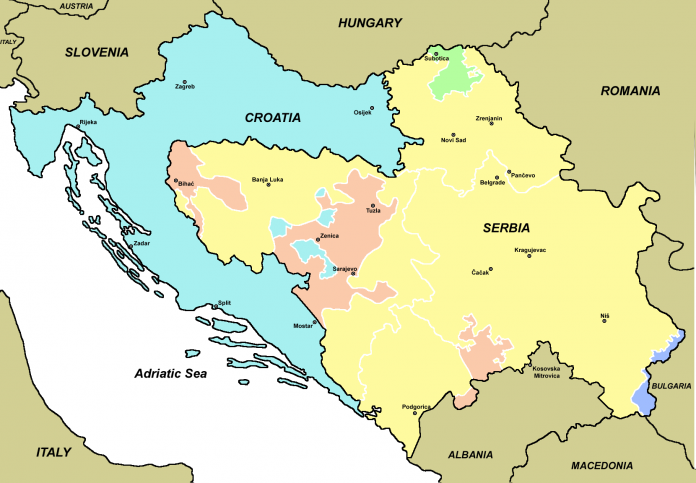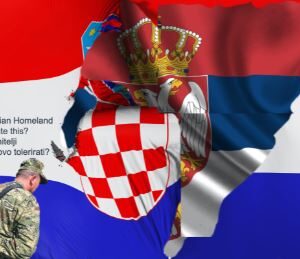Nothing exposes the vacuity of Croatia’s so-called ‘foreign policy’ than the response of the government of Andrija Plenkovic to the recent election results in neighbouring Montenegro.
Those events are nothing short of seismic. As the northern hemisphere entered autumn, the Balkans entered a new season of instability with the Serbian Orthodox Church (SPC) and the supporters of the Greater Serbia ideology emerging as winners in the recent Montenegrin elections by using religion to mobilise and tap into the Serbs’ self-nurtured notion of historical ‘victimhood’.
After being in power for 30 years, Montenegro’s governing party, the Democratic Party of Socialists (DPS) led by Milo Dukanovic lost out to three pro-Serb and pro-Russian opposition coalitions – Peace is Our Nation, Black on White coalition and For the Future of Montenegro alliance – which secured 41 out of 81 parliament seats.
While all this started when the DPS passed a religious reform law that sought to cement the autocephaly of the Montenegrin Orthodox Church, which was dissolved by the Serbs in 1918, this issue has been bubbling under the surface for at least the past two decades.
After all, the Serbs never accepted the break-up of Yugoslavia 20 years ago and have long lamented for a new ‘Greater Serbia’.
This was also articulated by former Serbian Prime Minister Boris Tadic who published his concept of an expanded Serb state in 2014.
As for Croatia’s ruling HDZ, it was as if all this was happening on the western shores of Antarctica rather than 55 minutes flying time from Zagreb.
As if to remind anyone with historical amnesia, the tactics used by the pro-Serb alliance in Montenegro – such as roadblocks were eerily reminiscent of the ones employed in Croatia during the Serb-led ‘Balvan revolucija’ that led to the creation of the so-called ‘Serbian Autonomous Krajina’ region in the early 1990s.
Chillingly, Andrija Mandic, from the ‘For the Future of Montenegro’ alliance, threatened to “dig up the buried weapons”, a thinly-veiled reference to the massacres of Muslims in places like Srebrenica while at the same time, calling on the country’s Muslim MPs whose support was crucial to maintaining a DPS majority in parliament, not to back the religious reform law, saying “if you come after our church, we will come after your homes”.
Mandic’s comments should not be taken lightly, considering he is known to have been a supporter of convicted war criminals Radovan Karadzic and Vojislav Seselj as well as being a disciple of what American historian Michael Sells calls “Christoslavism,” a blend of Eastern Orthodox Christianity and expansionist Slavic nationalism, which sees Slavic Muslims as ‘apostates’ from Christianity.
The Plenkovic government’s response to all this was a cowardly form of radio silence – it took the government in Zagreb two full days to even respond to the events occurring with its fellow NATO ally.
But none of this should be a surprise to anyone with even a casual understanding of Balkan history.
For example, according to Boris Begović, professor of economics at the School of Law, University of Belgrade, democracy, pluralism and the Serbian Orthodox Church (SPC) have always made uneasy bedfellows. “Orthodox Christianity was not a barrier to liberal democracy in Serbia: rather, it was the other way around. In other words, he says, a robust and viable democracy was a barrier to Orthodoxy,” writes Begović.
Serbia’s Women in Black human rights movement says that “Portraying itself as the saviour and keeper of Serbian identity, the [Serbian Orthodox] church uses the nationalist rhetoric of a divinely ordained “Greater Serbia”.
But this is not just about territory – it’s also about money – lots of money and huge amounts of property.
The SPC knows that without a monopoly in society, it will wither like a flower in a desert – the example of what happened to the post-Reformation Catholic Church is a lesson the SPC’s leadership has learnt well.
This was noted by Dragan Šljivić and Andrijana Maksimović in their 2018 study, Orthodox Christians and democracy in Serbia: “… the relationship of Orthodoxy and democracy is often posed as a discussion of two opposing concepts. We can call this ‘the thesis of incompatibility’, which contains the view that the Orthodox Church has formed dominant Orthodox societies, so that it now faces difficulties in democratization and democratic consolidation.”
This ‘incompatibility’ manifested itself in December 2019, when Montenegro passed its religious reform law that registered as state property all religious buildings and sites formerly owned by the independent kingdom of Montenegro before it became part of the Serb-dominated Yugoslavia in 1918.
The new law stated that religious communities can only ‘retain their assets if they can produce clear evidence of the right to ownership’, triggering accusations from the SPC that Montenegro plans to ‘dispute its holdings’.
However, this is only part of the new law – the other part aims to turn the country into a secular state as well as making the formerly supressed Montenegrin Orthodox Church (CPC) equal in status with all other religions, including, and particularly, the SPC.
Now thanks to the SPC-inspired coalition’s election win, it seems the Serb church has its own country – Krajina 2.0 – this time complete with its own navy in the Bay of Kotor, literally a 30-minute drive from Croatia’s southernmost border.
But that’s not all.
In the increasingly autonomous Serb-run part of neighbouring Bosnia & Herzegovina (BiH), plans are afoot to turn the city of Banja Luka into European ‘capital’ with designs for a new city-centre leaked to the press by well-known European urban planning and design firm Cosmos Architecture.
Hardly a surprise really, as Serb nationalists see BiH as the ‘jewel in their crown’ and have started four wars over Bosnia’s ownership, one of them World War 1 that resulted in the deaths of some 20 million people.
Then again, much of this would not be possible without the passive-aggressive involvement of Plenkovic’s HDZ, where its BiH branch under the moribund and corrupt reign of Ante Covic acts as a ‘wingman’ for Bosnian Serb leader Milorad Dodik’s political interests.
And all this with Zagreb’s ‘blessing’, the same Zagreb which out of fear of a Montenegrin-style SPC backlash, to this day refuses to even discuss recognising the fledgling Croatian Orthodox Church (HPC), despite this being in direct contravention of Article 41 of the Croatian Constitution and a range of EU laws.
If this continues – and nothing it seems says that it won’t – the Serbs within 10-15 years may well end up with three states – the current Republic of Serbia, Adriatic Serbia (Montenegro) and ‘western’ (Bosnian) Serbia. The most Croatia would get out of this geopolitical land grab is a small slice of western Hercegovina.
So as the HDZ is busy turning Croatia into the ‘Costa Rica of Europe’ and Serbia expands westwards, Andrej Plenkovic and his servile ministers mindlessly ape empty platitudes about ‘diversity’ and ‘inclusivity’ to fill the ears of left-leaning EU bureaucrats.
A few days ago, Bishop Mihailo Dedeić, the head of the Montenegrin Orthodox Church, said in an interview that “Montenegro has many traitors, while you had only one in Croatia.”
That may or may not be true, but one thing is for sure: it’s time for the HDZ to remove the ‘H’ from its name because it doesn’t have a grain of Croatia’s interest left in itself.




